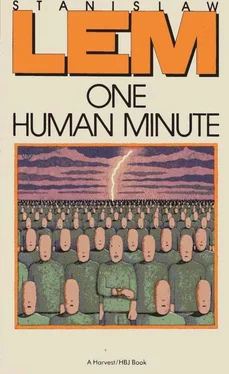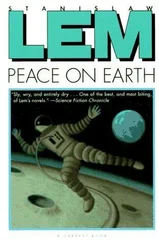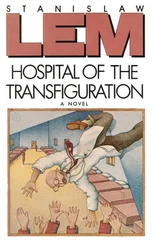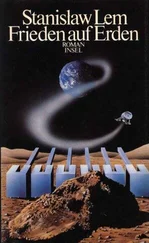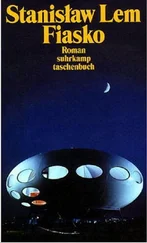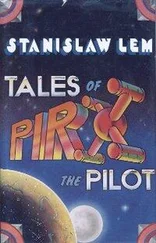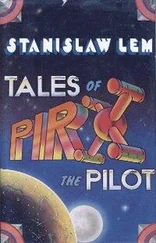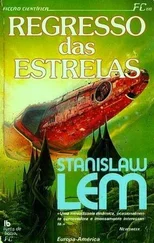On the other hand, the statistics of Chapter One are beyond reproach. They tell how many people there are — and thus how many living human bodies — in each minute of the 525,600 minutes of the year. How many bodies means: the amount of muscle, bone, bile, blood, saliva, cerebrospinal fluid, excrement, and so on. Naturally, when the thing to be visualized is of a very great order of magnitude, a popularizer readily resorts to comparative imagery. The Johnsons do the same. So, were all humanity taken and crowded together in one place, it would occupy three hundred billion liters, or a little less than a third of a cubic kilometer. It sounds like a lot. Yet the world’s oceans hold 1,285 million cubic kilometers of water, so if all humanity — those five billion bodies — were cast into the ocean, the water level would rise less than a hundredth of a millimeter. A single splash, and Earth would be forever unpopulated.
Games of this sort with statistics can rightly be called cheap. They may be meant as a reminder that we — who with the might of our industry poisoned the air, the soil, the seas, who turned jungles into deserts, who exterminated countless species of animals and plants that had lived for hundreds of millions of years, who reached other planets, and who altered even the albedo of the Earth, thereby revealing our presence to cosmic observers — could disappear so easily and without a trace. However, I was not impressed. Nor was I impressed by the calculation that 24.9 billion liters of blood could be poured from all mankind and it would not make a Red Sea, not even a lake.
After this, under an epigraph from T. S. Eliot saying that existence is “birth, and copulation, and death,” come new figures. Every minute, 34.2 million men and women copulate. Only 5.7 percent of all intercourse results in fertilization, but the combined ejaculate, at a volume of forty-five thousand liters a minute, contains 1,990 billion (with deviations in the last decimal place) living spermatozoa. The same number of female eggs could be fertilized sixty times an hour with a minimal ratio of one spermatozoon to one egg, in which impossible case three million children would be conceived per second. But this, too, is only a statistical manipulation.
Pornography and our modern life style have accustomed us to the forms of sexual life. You would think that there was nothing left to reveal, nothing to show that would shock. But, presented in statistics, it comes as a surprise. Never mind the game of comparisons which is put to use again: for instance, the stream of sperm, forty-three tons of it, discharged into vaginas per minute — its 430,000 hectoliters is compared with the 37,850 hectoliters of boiling water produced at each eruption of the largest geyser in the world (at Yellowstone). The geyser of sperm is 11.3 times more abundant and shoots without intermission. The image is not obscene. A person can be aroused sexually only within a certain range of magnitudes. Acts of copulation, when shown in great reduction or great enlargement, do not elicit any sexual response. Arousal, an inborn reaction, occurs as a reflex in certain centers in the brain, and does not manifest itself in conditions that exceed visual norms. Sexual acts seen in reduced dimensions leave us cold, for they show creatures the size of ants.
Magnification, on the other hand, arouses disgust, because the smoothest skin of the most beautiful woman will then look like a porous, pale surface from which protrude hairs as thick as fangs, while a sticky, glistening grease oozes from the ducts of the sebaceous glands.
The surprise I spoke of has a different cause. Humanity pumps 53.4 billion liters of blood per minute, but that red river is not surprising; it must flow to sustain life. At the same time, humanity’s male organs eject forty-three tons of semen, and the point is that though each ejaculation is also an ordinary physiological act, for the individual it is irregular, intimate, not overly frequent, and even not necessary. Besides, there are millions of old people, children, voluntary and involuntary celibates, sick people, and so forth. And yet that white stream flows with the same constancy as the red river system. The irregularity disappears when the statistics take in the whole Earth, and that is what surprises. People sit down to tables set for dinner, look for refuse in garbage dumps, pray in chapels, mosques, and churches, fly in planes, ride in cars, sit in submarines carrying nuclear missiles, debate in parliaments; billions sleep, funeral processions walk through cemeteries, bombs explode, doctors bend over operating tables, thousands of college professors simultaneously enter their classrooms, theater curtains lift and drop, floods swallow fields and houses, wars are waged, bulldozers on battlefields push uniformed corpses into ditches; it thunders and lightnings, it is night, day, dawn, twilight; but no matter what happens that forty-three-ton impregnating stream of sperm flows without stop, and the law of large numbers guarantees that it will be as constant as the sum of solar energy striking Earth. There is something mechanical about this, inexorable, and animallike. How can one come to terms with an image of humanity copulating relentlessly through all the cataclysms that befall it, or that it has brought upon itself?
Well, there you have it. Keep in mind that it is impossible to summarize a book that reduces human affairs to a minimum — that is, to numbers (there is no more radical method of cramming phenomena together). The book itself is an extract, an extreme abbreviation of humanity. In a review one cannot even touch on the most remarkable chapters. Mental illnesses: it turns out that today there are more lunatics in any given minute than all the people who lived on Earth for the last several dozen generations. It is as if all of previous humanity consisted, today, of madmen. Tumors — in my first medical work thirty-five years ago I called them a “somatic insanity,” in that they are a suicidal turning of the body upon itself — are an exception to life’s rule, an error in its dynamics, but that exception, expressed in the statistics, is an enormous Moloch. The mass of cancerous tissue, calculated per minute, is a testimony to the blindness of the processes that called us into existence. A few pages farther on are matters even more dreary. I pass over in silence the chapters on acts of violence, rape, sexual perversion, bizarre cults and organizations. The picture of what people do to people, to humiliate them, degrade them, exploit them, whether in sickness, in health, in old age, in childhood, in disability — and this incessantly, every minute — can stun even a confirmed misanthrope who thought he had heard of every human baseness. But enough of this.
Was this book necessary? A member of the French Academy, writing in Le Monde, said that it was inevitable, it had to appear. This civilization of ours, he wrote, which measures everything, counts everything, evaluates everything, weighs everything, which breaks every commandment and prohibition, desires to know all. But the more populous it becomes, the less intelligible it is to itself. It throws itself with the most fury at whatever continues to resist it. There was nothing strange, therefore, in its wanting to have its own portrait, a faithful portrait, such as never existed, and an objective one — objectivity being the order of the day. So in the cause of modern technology it took a photograph like those done with a reporter’s flash camera: without touch-ups.
The old gentleman dodged the question about the need for One Human Minute, saying that it appeared because, as the product of its time, it had to appear. The question, however, remains. I would substitute for it another, more modest question: Does this book truly show all of humanity? The statistical tables are a keyhole, and the reader, a Peeping Tom, spies on the huge naked body of humanity busy about its everyday affairs. But through a keyhole not everything can be seen at once. More important, perhaps, is the fact that the observer stands eye to eye, as it were, not merely with his own species but with its fate. One has to admit that One Human Minute contains a great deal of impressive anthropological data in the chapters on culture, beliefs, rituals, and customs, because, although these are numerical agglomerations (or maybe for precisely that reason), they demonstrate the astonishing diversity of people who are, after all, identical in their anatomy and physiology. It is curious that the number of languages people employ cannot be calculated. No one knows precisely how many there are; all we know is that there are over four thousand. Even the specialists have not identified all of them. The fact that some small ethnic groups take their languages with them when they die out makes the matter even more difficult to settle. On top of that, linguists are not in agreement about the status of certain languages, considered by some to be dialects, by others separate taxonomic entities. Few are the cases, however, where the Johnsons admit defeat in the conversion of all data to events per minute. Yet it is just in such cases that one feels — at least I felt — a kind of relief. This is a matter with philosophical roots.
Читать дальше
